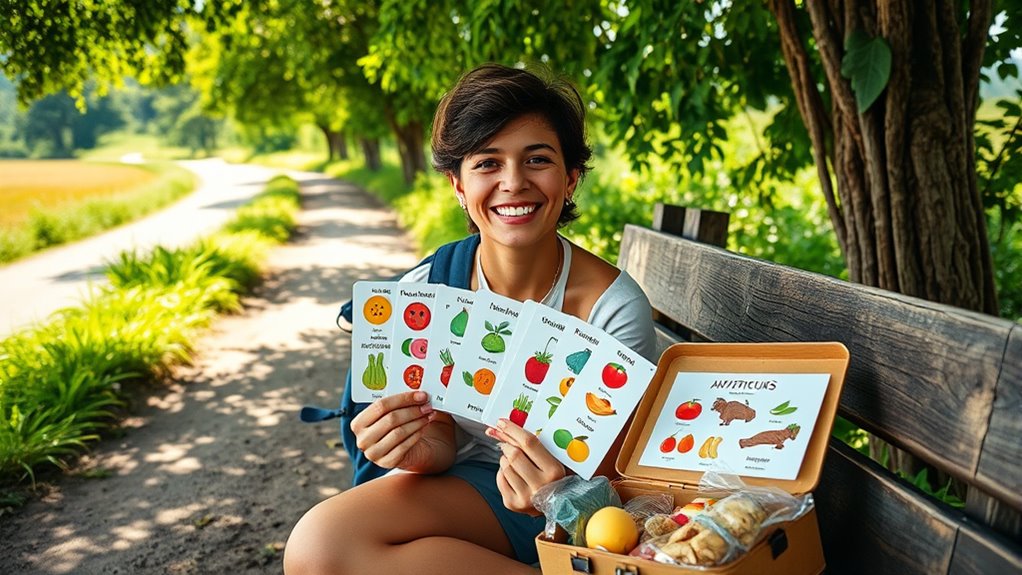Traveling as a vegan in rural areas can be tricky, but using simple, culturally respectful language cards helps communicate your needs clearly. Carry snack kits with portable, familiar plant-based foods like nuts, dried fruit, and regional treats for quick energy. Combining visual communication tools with digital translation apps enhances understanding. With some planning and flexibility, you can enjoy your trip without missing out—stay tuned to discover more ways to make your journey smooth and enjoyable.
Key Takeaways
- Use culturally respectful, high-contrast visual language cards with minimal text to clearly communicate vegan needs in rural settings.
- Prepare portable, culturally appropriate snack kits with nuts, dried fruits, and plant-based treats to maintain energy and dietary compliance.
- Include region-specific phrases and images on language cards, and utilize translation apps for effective communication with locals.
- Carry compact, airtight containers for easy organization and freshness of snacks, ensuring quick access during travel.
- Research local cuisine and customs beforehand to identify vegan-friendly options and avoid ingredients containing animal products.
Why Language Barriers Can Be Challenging for Vegan Travelers
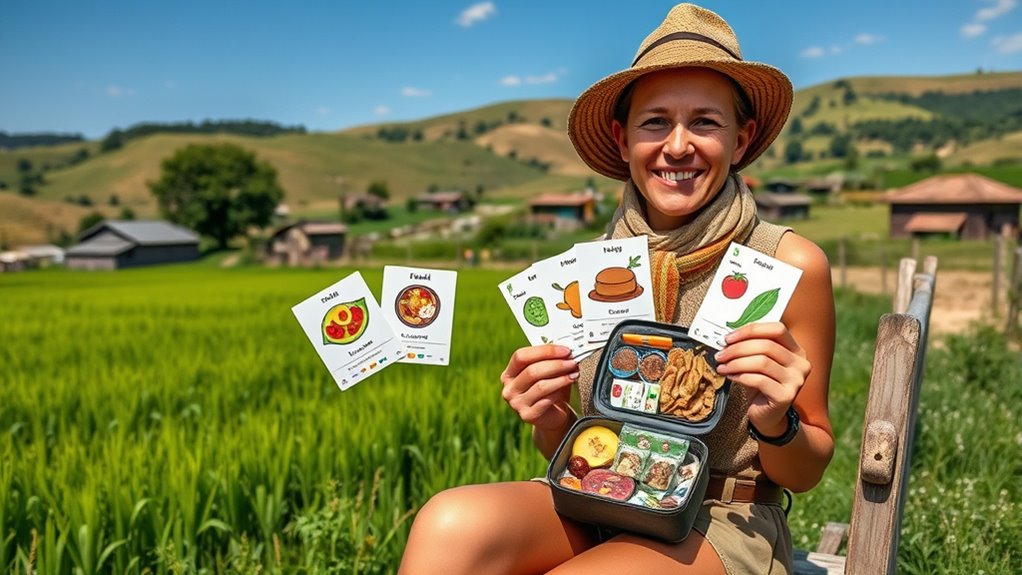
Language barriers can make it difficult for vegan travelers to communicate their dietary needs clearly, especially in rural areas where English may not be widely spoken. When language barriers exist, you might struggle to explain that you don’t eat animal products, leading to misunderstandings. Cultural differences can amplify this challenge, as food customs and dietary norms vary widely across regions. In some places, veganism may be unfamiliar or misunderstood, making it harder to find suitable meals. You may face skepticism or confusion, which can result in limited options or accidental consumption of non-vegan foods. Overcoming these obstacles requires patience and creative communication strategies. Recognizing how language barriers and cultural differences intersect helps you prepare better and navigate rural settings more confidently. Additionally, understanding communication strategies and concepts like open dialogue and empathy can facilitate more effective communication in challenging situations.
Crafting Effective Language Cards for Rural Settings
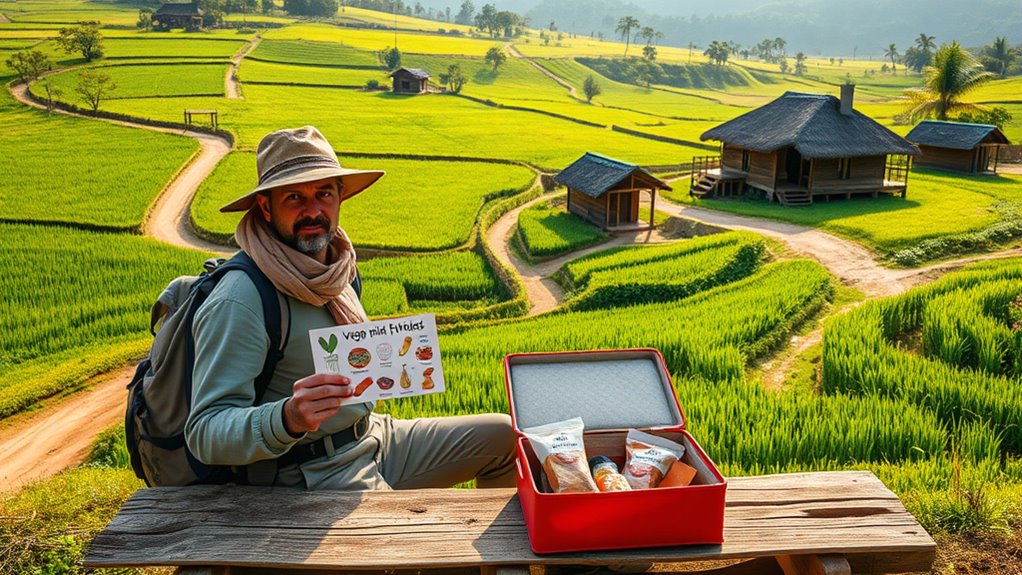
To create effective language cards, prioritize clear visuals that quickly convey your message. Be mindful of local customs and sensitivities to guarantee your cards respect cultural differences. Combining simple images with respectful language helps you communicate your needs confidently in rural settings. Incorporating local culture and history into your cards can further enhance understanding and foster positive interactions.
Clear Visuals Essential
When traveling in rural areas, clear visuals become essential for effective communication, especially when language barriers arise. You need visuals that are simple and instantly recognizable. Consider these four key elements:
- Bright, high-contrast images that stand out.
- Clear labels with large, legible fonts.
- Illustrations depicting specific vegan foods or phrases.
- Minimal text, relying instead on visuals to convey meaning. Using visual communication techniques enhances understanding and reduces misunderstandings in unfamiliar settings. Incorporating rural aesthetics into your visuals can further improve their effectiveness, ensuring they resonate with local environments. These visuals help bridge gaps in rural settings where locals may not speak your language fluently. They ensure your message is understood quickly and accurately, reducing confusion and frustration. By using straightforward, well-designed visuals, you make it easier for everyone to communicate effectively despite language barriers in rural settings. This approach keeps your interactions smooth and respectful.
Cultural Sensitivity Matters
Clear visuals help you communicate quickly and avoid misunderstandings in rural areas, but respecting local customs and sensitivities is equally important. When crafting language cards, consider the region’s culinary traditions and dietary etiquette. Some communities might have specific rules about food sharing or particular ingredients to avoid, especially in rural settings where traditions run deep. Use respectful language that acknowledges these customs, and include visuals that reflect local dishes or practices. Showing awareness of cultural nuances demonstrates your respect and helps build trust. Incorporating cultural awareness and an understanding of local food etiquette into your approach helps foster positive interactions and ensures your vegan message is understood and appreciated within the local context. Being attentive to local food customs can prevent unintentional offenses and enhance your connection with the community. Additionally, understanding traditional food practices can aid in designing more effective and respectful communication tools that resonate with the community’s values.
Essential Items to Include in Your Snack Kit
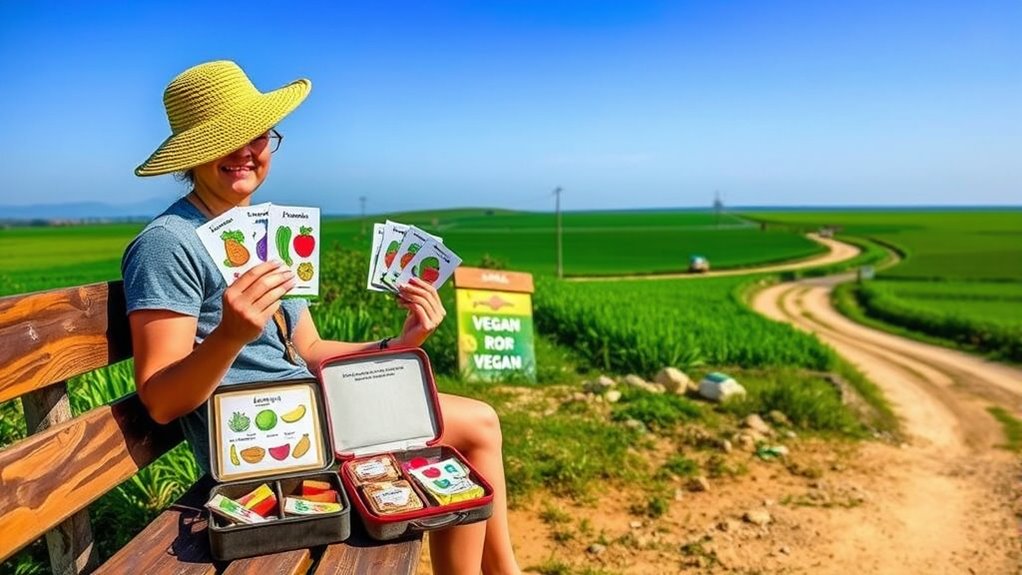
Packing a well-stocked snack kit is essential for staying energized and satisfied during your rural adventures. It helps you respect local food customs and ensures you follow travel safety tips. Here are four must-have items:
- Nut and seed packs for quick protein boosts.
- Dried fruit or trail mix for natural sugars and energy.
- Vegan energy bars that align with local food customs.
- Reusable utensils and napkins for convenience and eco-friendliness.
These items keep you nourished without relying on unfamiliar or inaccessible options. It’s smart to carry snacks that travel well and are versatile, especially when local markets may have limited vegan choices. With a prepared snack kit, you’ll stay energized and respect local customs, making your rural trip smoother and more enjoyable.
Tips for Using Language Cards to Communicate Your Dietary Needs

Carrying a well-prepared set of language cards can make communicating your vegan dietary needs much easier when you’re in rural areas where language barriers and limited menu options exist. To maximize their effectiveness, keep your cards simple, clear, and visually descriptive. Use basic phrases and icons to convey your requirements quickly, especially if a language barrier makes spoken communication difficult. Practice pronouncing key phrases beforehand to ensure smooth delivery. Show your cards with confidence and patience, being respectful of cultural sensitivity; some cultures may have different perceptions of dietary restrictions. Always remain polite and open to alternative explanations or suggestions. Remember, a respectful approach combined with clear visuals can bridge language gaps and help you maintain your vegan lifestyle smoothly. Additionally, understanding Pimple Patch options in different regions can be helpful if skin concerns arise during travel.
Building a Portable Vegan Snack Kit for On-the-Go Convenience
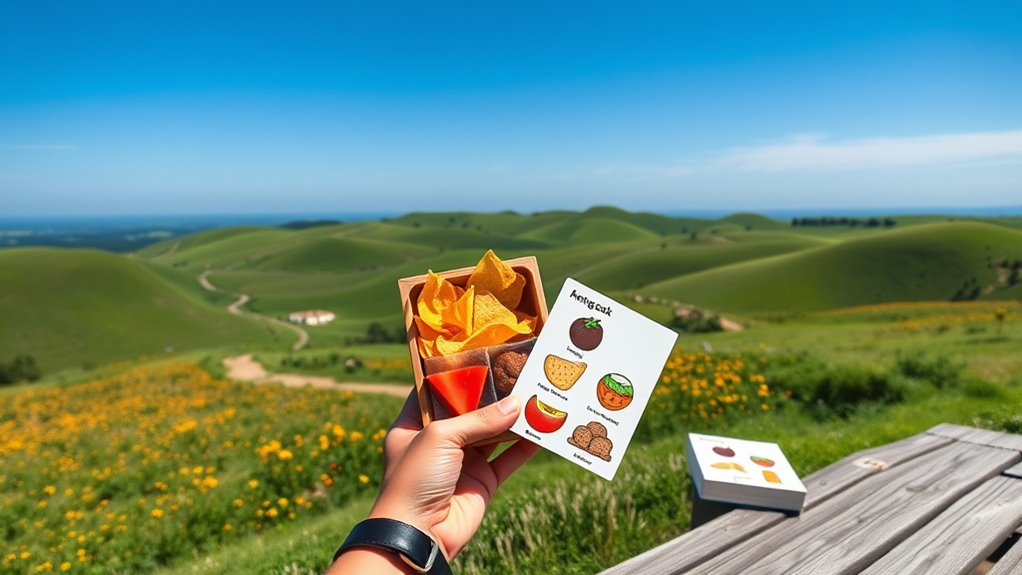
Creating a portable vegan snack kit starts with choosing essential snacks that are easy to carry and energizing. You’ll want compact storage solutions that keep your snacks fresh and accessible throughout your trip. Don’t forget to include a balance of nutrients to stay fueled and healthy on the go.
Essential Snack Choices
What are the best vegan snacks to keep you energized and satisfied during rural travels? When planning your trip, choose options that align with local cuisine and are easy to carry. Consider these essentials for a portable vegan snack kit:
- Trail mix with nuts, seeds, and dried fruit for quick energy.
- Nut butter packets paired with whole-grain crackers or fruit.
- Fresh fruit like apples, oranges, or bananas for natural hydration.
- Vegan granola bars that combine taste and convenience.
These snacks ensure you stay fueled while enjoying local flavors and managing your travel planning efficiently. They’re perfect for long drives or quick stops, letting you focus on exploring without hunger interruptions. Keep your snack choices simple, nutritious, and adaptable to rural settings.
Compact Storage Solutions
To keep your vegan snacks fresh and accessible during rural trips, investing in compact storage solutions is essential. Using portable containers helps organize your snacks efficiently, preventing spills and spoilage. Look for small, airtight containers that fit easily into your bag or cooler, ensuring your food stays fresh longer. Stackable, leak-proof options are ideal for nuts, dried fruits, and cut veggies. Consider collapsible silicone jars for versatility and space savings. Label your containers for quick identification, especially if you’re packing multiple items. By choosing the right compact storage, you streamline your snack kit, making it easier to access healthy options on the go. This approach keeps your vegan snacks fresh, organized, and ready whenever you need them during your rural adventures.
Nutritional Balance Tips
Ensuring your vegan snack kit offers a balanced mix of nutrients is key to keeping your energy up during rural adventures. Focus on variety to meet your nutritional needs. Here are four tips:
- Include a source of vegan protein like roasted chickpeas or trail mix with nuts and seeds.
- Add whole grains such as rice cakes or whole-grain crackers for sustained energy.
- Incorporate colorful fruits and vegetables, like dried apricots or carrot sticks, to boost vitamin intake.
- Pack healthy fats from avocado slices or nut butters to support overall nutrient absorption.
- Consider incorporating GMC tuning techniques to optimize your vehicle’s performance and fuel efficiency during long travels.
Navigating Local Markets and Restaurants With Confidence
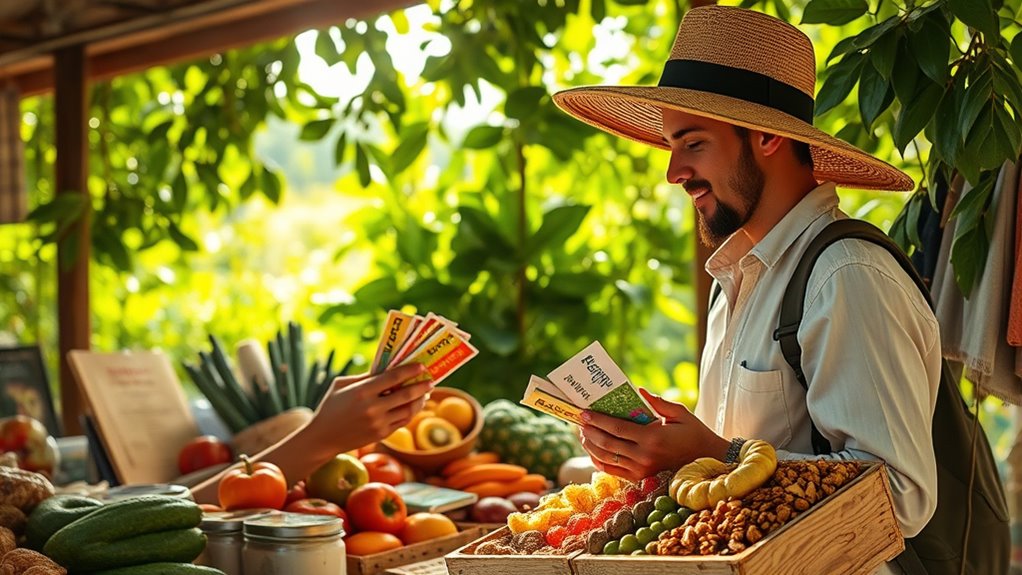
Exploring local markets and restaurants can feel intimidating, especially when you’re in a rural area where options might be limited or unfamiliar. To navigate confidently, learn a few local language phrases related to veganism; simple words like “vegetarian” or “vegan” can go a long way. Respect cultural etiquette by observing how locals order and serve food—smiling and using polite gestures help build rapport. Point to ingredients or dishes when language barriers exist, and don’t hesitate to ask about preparation methods to ensure your meal aligns with your diet. Be adaptable and patient, recognizing that customs vary. With a little preparation and awareness of local language and etiquette, you’ll find it easier to enjoy meals without stress, making your journey more enjoyable and stress-free.
How to Find Hidden Vegan Options in Rural Areas

To find hidden vegan options in rural areas, start exploring local markets and talking to vendors about your dietary needs. Keep an eye out for vegan signs or labels that can guide you to plant-based choices. Clear communication and attentive spotting can reveal tasty surprises off the beaten path. Additionally, learning basic phrases related to veganism or carrying language cards can facilitate smoother conversations with locals unfamiliar with your diet. Being aware of essential oils for plant-based health can also help you recognize natural ingredients used in local remedies or foods that align with vegan preferences. Recognizing local culinary customs can further enhance your ability to identify vegan-friendly dishes during your travels.
Local Market Exploration
In rural markets, finding hidden vegan options requires a keen eye and a bit of curiosity. Local produce is often the best place to start. Look for fresh vegetables, fruits, and herbs that aren’t pre-packaged. Here’s what to do:
- Explore stalls with vibrant displays of seasonal local produce.
- Ask vendors about their farm-fresh offerings—many may have vegan-friendly items not labeled.
- Scan for dried goods like beans, grains, and nuts, which are versatile vegan staples.
- Check for homemade or artisanal products, such as fresh sauces or pickles, that may contain plant-based ingredients.
- Be aware that security features like password strength indicators and user profile management can help ensure your online safety when researching local markets or connecting with vendors digitally.
Communicating Dietary Needs
When searching for hidden vegan options in rural areas, effective communication with vendors and locals is essential. Language barriers can make it challenging to explain your dietary needs clearly, so having simple, translated language cards can help bridge gaps. Approach conversations with cultural sensitivity, respecting local customs and food practices. Be patient and polite if misunderstandings occur, and use gestures or visual aids to clarify. Building rapport with shop owners or farmers can also lead to valuable suggestions for hidden vegan options. Remember, many rural communities are welcoming, but patience and respect go a long way. Additionally, understanding how local cuisine and food practices influence available options can help you better navigate the food landscape. Being aware of state tax laws and how they affect your expenses can also inform your plans for purchasing or preparing meals. By being proactive and considerate, you’ll increase your chances of discovering delicious vegan dishes that might otherwise be overlooked.
Spotting Vegan Signs
Often, the easiest way to spot hidden vegan options in rural areas is by carefully observing signage and product labels. Pay attention to subtle hints that respect vegan etiquette and your dietary restrictions. Look for:
- Small stickers or symbols indicating vegan-friendly items, often tucked away on shelves.
- Menus with clearly marked vegan dishes or symbols next to items.
- Signs outside shops or restaurants mentioning plant-based options.
- Package labels that specify “vegan,” “plant-based,” or “suitable for vegans.”
Combining Technology and Traditional Tools for Better Communication
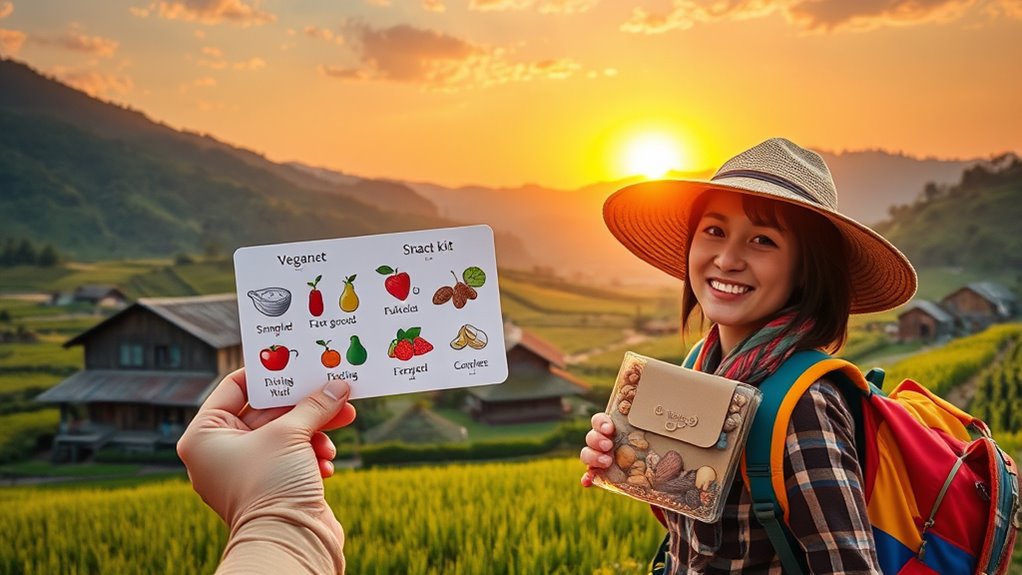
Blending modern technology with traditional communication tools can substantially enhance your ability to connect in rural areas. Using digital translation apps alongside language cards allows you to quickly overcome language barriers. This combo boosts cultural awareness, ensuring respectful and effective interactions. For example, digital tools can translate phrases instantly, while language cards provide visual cues for clarity. To visualize, here’s a helpful table:
| Traditional Tools | Digital Tools |
|---|---|
| Language cards | Translation apps |
| Picture charts | Audio pronunciation guides |
| Hand gestures | Cultural tips via apps |
| Printed phrases | Real-time translation devices |
This integration helps you navigate conversations smoothly, building trust and understanding in unfamiliar environments. Combining these tools empowers you to communicate confidently while respecting local customs.
Staying Energized: Quick and Easy Vegan Snack Ideas
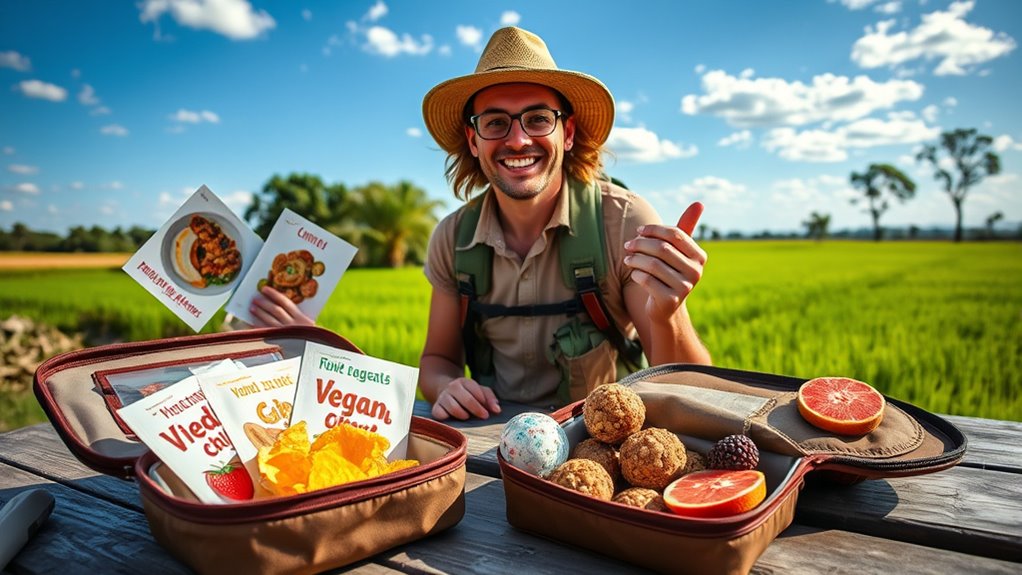
Keeping your energy up on the go is simple with quick and easy vegan snacks that require minimal prep. Cultural nuances and language proficiency can sometimes make selecting snacks tricky, but these options are universally satisfying. Here are four ideas to keep you fueled:
- Nut and seed packs—compact, portable, and rich in healthy fats.
- Fresh fruit—easy to find and naturally sweet.
- Vegan energy bars—convenient and packed with carbs.
- Veggie sticks with hummus—crunchy, satisfying, and high in protein.
These snacks are perfect for rural travel, where grocery options might be limited. They’re simple to prepare and adapt, regardless of language barriers or cultural differences. Staying energized has never been easier, even in remote areas.
Adapting Your Strategies for Different Rural Regions

How can you effectively adapt your vegan travel strategies to suit the unique characteristics of different rural regions? Start by researching local cuisine and cultural customs beforehand. In some areas, traditional dishes may contain animal products, so knowing how to ask about ingredients is vital. Respect cultural customs by observing local dining etiquette and being sensitive to flavors and ingredients that hold cultural significance. Carry language cards that include key phrases related to veganism and dietary restrictions, tailored to the region’s language and customs. Adjust your snack kits to include familiar plant-based options that align with local tastes. Flexibility is essential—embrace local food practices when appropriate, and communicate openly to guarantee positive experiences while staying true to your vegan lifestyle.
Frequently Asked Questions
How Can I Learn Basic Local Phrases Related to Vegan Options Quickly?
To learn basic local phrases related to vegan options quickly, start with phrase flashcards that focus on common vegan slang and key questions. Practice daily, emphasizing pronunciation and understanding. Use apps or create your own flashcards for quick recall. This active approach helps you communicate your dietary needs confidently, even if language barriers exist. The more you practice, the more natural it becomes to ask about vegan choices wherever you go.
What Are Some Common Rural Ingredients That Can Be Vegan-Friendly?
You can find common rural ingredients that are vegan-friendly by exploring local foraging and traditional plant-based foods. Look for wild herbs, berries, nuts, and vegetables that grow naturally in the area. These ingredients are often used in traditional dishes and are excellent for maintaining a vegan diet while traveling rural. Embracing local foraging helps you discover authentic, traditional plant-based options that are both fresh and sustainable.
How Do I Handle Language Misunderstandings Without Causing Offense?
Think of cultural sensitivity as a dance—you need to be aware of your steps to avoid stepping on toes. When language misunderstandings happen, stay calm and use non-verbal communication like gestures or smiles to bridge gaps. I once struggled with a language barrier, but a friendly nod and a laugh eased tension. Respectful body language and patience show your good intentions, helping you connect without causing offense.
Are There Specific Cultural Norms I Should Be Aware of When Discussing Food?
When discussing food, you should be mindful of traditional dining etiquette and food-related taboos. Respect local customs by observing how people eat and avoiding controversial topics. Use polite language, ask questions gently, and listen carefully. In some cultures, certain foods are sacred or taboo, so steer clear of criticizing local dishes. Showing genuine interest and respect helps you connect and avoid misunderstandings or offense.
How Can I Connect With Local Vegans or Vegetarian Communities in Rural Areas?
Imagine you’re a modern-day explorer, like a digital nomad of sorts. To connect with local vegans or vegetarians, check out local event meetups and attend gatherings. Also, join online community groups for advice and friendship. These platforms help you find like-minded people, share tips, and build genuine connections. Engaging with the community makes your rural adventure more meaningful, and you might even make lifelong friends along the way.
Conclusion
Think of yourself as a seasoned explorer steering uncharted rural lands. Your language cards and snack kits are your trusted map and compass, guiding you past language barriers and nourishing you along the way. With these tools in hand, you’ll uncover hidden vegan treasures and forge connections in unexpected places. Embrace your adventure with confidence, knowing that every step forward brings you closer to delicious discoveries and meaningful experiences in your journey.

